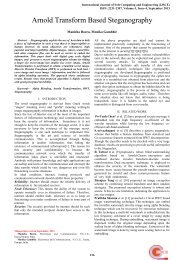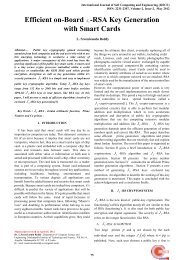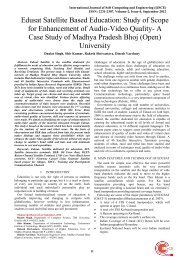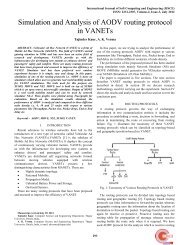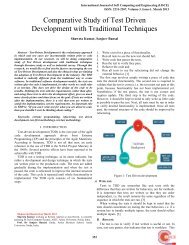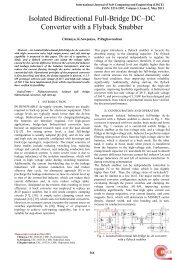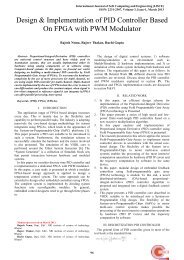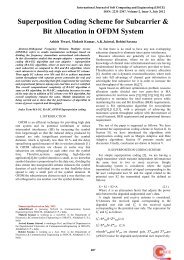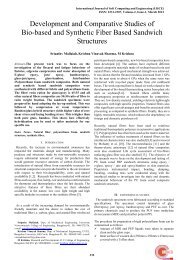Preparation of Papers in Two-Column Format - International Journal ...
Preparation of Papers in Two-Column Format - International Journal ...
Preparation of Papers in Two-Column Format - International Journal ...
Create successful ePaper yourself
Turn your PDF publications into a flip-book with our unique Google optimized e-Paper software.
Tun<strong>in</strong>g Of PID Controller Of Inverted Pendulum Us<strong>in</strong>g Genetic Algorithm<br />
2<br />
L= ( +2 cos +<br />
2 +<br />
2 2<br />
)+ ]- cos<br />
The Euler-Lagrange’s equation for the system is given as<br />
=<br />
Us<strong>in</strong>g these two above equations we get the dynamics <strong>of</strong> the<br />
entire system<br />
……….(1)<br />
……..(2)<br />
F<br />
The system poles lies on R.H plane, hence system is<br />
unstable.<br />
Table 1. Parameters <strong>of</strong> the system from feedback<br />
<strong>in</strong>strument .U.K.<br />
Parameter Value unit<br />
Cart mass( ) 1.206 Kilo gram<br />
Mass <strong>of</strong> the<br />
pendulum( )<br />
Half Length <strong>of</strong><br />
pendulum( )<br />
Coefficient<br />
frictional force( )<br />
<strong>of</strong><br />
Pendulum damp<strong>in</strong>g<br />
coefficient(q)<br />
Moment <strong>of</strong> <strong>in</strong>ertia <strong>of</strong><br />
pendulum( )<br />
0.2693 Kilo gram<br />
0.1623 meter<br />
0.05 Ns/m<br />
0.005 /rad<br />
0.099 /<br />
Gravitation force( ) 9.8 /<br />
Fig 2 : The Inverted Pendulum System<br />
The above equation (1&2) shows the dynamics <strong>of</strong> the entire<br />
system.<br />
In order to derive the l<strong>in</strong>ear differential equation modell<strong>in</strong>g,<br />
we need to l<strong>in</strong>earaize the non l<strong>in</strong>ear differtional equation<br />
obta<strong>in</strong>ed as above so far. For small angle deviation around<br />
the upright equilibrium (fig.2) po<strong>in</strong>t assume<br />
Us<strong>in</strong>g above relation we can write as,<br />
r +q -k +d =0………..(3)<br />
…….(4)<br />
Where, ( + )= p, =k, =q, = r<br />
Eq (3&4) is the l<strong>in</strong>ear differential eqution modell<strong>in</strong>g <strong>of</strong> the<br />
entire system. In order to f<strong>in</strong>d the transfer function <strong>of</strong> the<br />
system , Laplace transform <strong>of</strong> Eq (3 & 4) has been taken out<br />
and substitut<strong>in</strong>g the parameter value (table 1), we got<br />
and<br />
IV. PERFORMANCE INDECES<br />
The design <strong>of</strong> a control system is an attempt to meet a set <strong>of</strong><br />
specifications which def<strong>in</strong>e the overall performance <strong>of</strong> the<br />
system <strong>in</strong> terms <strong>of</strong> certa<strong>in</strong> measurable quantities. In the<br />
normal way design <strong>of</strong> control system, some specific<br />
parametric values <strong>of</strong> the system are assumed and the control<br />
system is designed accord<strong>in</strong>gly to meet desired performance<br />
<strong>of</strong> the system. Here we used four most commonly<br />
mathematical functions as a performance <strong>in</strong>dex associated<br />
with error <strong>of</strong> a closed loop system. A performance <strong>in</strong>dex is a<br />
number which <strong>in</strong>dicates goodness <strong>of</strong> system performance.<br />
The objective is to design an optimal system by proper<br />
choice <strong>of</strong> its parameters such that the specified performance<br />
<strong>in</strong>dex is extremum-either m<strong>in</strong>imum or maximum. A<br />
performance <strong>in</strong>dex must be a s<strong>in</strong>gle positive number or zero,<br />
the latter be<strong>in</strong>g obta<strong>in</strong>ed if and only if the measure <strong>of</strong> the<br />
deviation becomes identically zero.<br />
The commonly used performance <strong>in</strong>deces (PI) are:<br />
Integral <strong>of</strong> squared error (ISE),<br />
J =<br />
Integral <strong>of</strong> time multiplied squared error (ITSE),<br />
J =<br />
Integral <strong>of</strong> absolute error (IAE),<br />
J =<br />
Integral <strong>of</strong> time multiplied absolute error (ITAE),<br />
J=<br />
Here the error is def<strong>in</strong>e as<br />
We have<br />
taken the stable reference model for angle whose transfer<br />
function is<br />
22



